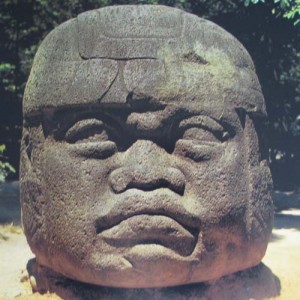- Attached to the essay "A Matter of Time"
How did the pattern begin?
Posted December 20, 2011 6:45 pm The first place to look is among the Olmec, the so-called “mother culture” of Mesoamerica. The Olmec established all the essential elements of Mexican civilization: an idiosyncratic pantheon, rituals of human sacrifice, a corn-based agriculture, formal cities—and the circular calendar. It is not known if they had the notion of the five epochs, but they are thought to have developed the Long Count and with it the belief in the finite nature of time. Their first ceremonial center, begun around 1500 B.C. on the Gulf Coast, with its pyramids, platforms, and ball court laid out on an axis just off north-south, is the prototype for every pre-conquest Mexican city that followed. The Olmec had hieroglyphs but, though contemporaneous with Troy, left no Iliad to tell us about them. What we know about them as fellow human beings—since burial remains were obliterated in the swampy region the Olmec inhabited—we can know only through their art. Most famously they carved, from six to nine foot high boulders, colossal heads of scowling, helmeted strong men assumed to be portrait monuments of great rulers. What sort of men were these? They must have had enormous power to have commanded the human labor necessary to construct and move their 12 to 24 ton monuments the 60 miles from their source. And the Olmec, like all the pre-conquest Indians, had no metal tools, pack animals, or wheels.
The first place to look is among the Olmec, the so-called “mother culture” of Mesoamerica. The Olmec established all the essential elements of Mexican civilization: an idiosyncratic pantheon, rituals of human sacrifice, a corn-based agriculture, formal cities—and the circular calendar. It is not known if they had the notion of the five epochs, but they are thought to have developed the Long Count and with it the belief in the finite nature of time. Their first ceremonial center, begun around 1500 B.C. on the Gulf Coast, with its pyramids, platforms, and ball court laid out on an axis just off north-south, is the prototype for every pre-conquest Mexican city that followed. The Olmec had hieroglyphs but, though contemporaneous with Troy, left no Iliad to tell us about them. What we know about them as fellow human beings—since burial remains were obliterated in the swampy region the Olmec inhabited—we can know only through their art. Most famously they carved, from six to nine foot high boulders, colossal heads of scowling, helmeted strong men assumed to be portrait monuments of great rulers. What sort of men were these? They must have had enormous power to have commanded the human labor necessary to construct and move their 12 to 24 ton monuments the 60 miles from their source. And the Olmec, like all the pre-conquest Indians, had no metal tools, pack animals, or wheels.
 Much work has gone into calculating the size of the population capable of providing such stupendous manpower: 1000 men, with a supporting population of 4000-5000 people, for the transportation of just one Head. And hundreds of colossal monuments of various types have so far been excavated. Furthermore, each major center was a metropolis constructed entirely of non-local material—thousands of tons of serpentine blocks and basalt columns and hundreds of thousands of tons of artificial fill—all transported on the backs of men. Olmec suburban populations would have numbered in the tens of thousands and been spread over many dozens of miles. The political power and organizational skills necessary to produce such monumental works, to extract such labor, and to control such a population would have been considerable.
Much work has gone into calculating the size of the population capable of providing such stupendous manpower: 1000 men, with a supporting population of 4000-5000 people, for the transportation of just one Head. And hundreds of colossal monuments of various types have so far been excavated. Furthermore, each major center was a metropolis constructed entirely of non-local material—thousands of tons of serpentine blocks and basalt columns and hundreds of thousands of tons of artificial fill—all transported on the backs of men. Olmec suburban populations would have numbered in the tens of thousands and been spread over many dozens of miles. The political power and organizational skills necessary to produce such monumental works, to extract such labor, and to control such a population would have been considerable.
Yet, by 350 B.C., the Olmec civilization had come to an end. Their major cities arose, one after the other, over a period of 800 years and then at each city—again, over a similar period—the furious construction suddenly halted and the cities were abandoned, in some, the monuments systematically mutilated and buried. Evidence suggests a remnant group of survivors stayed nearby while others dispersed. Whatever the destructive mechanism that brought the Olmec, in city after city, from a peak of civilization to complete disintegration, it is clear that collapse occurred in Mexico from the very beginning. The Olmec set the precedent; it may even have been part of their unique cultural legacy.
topics: culture
share
 site feed
site feed


